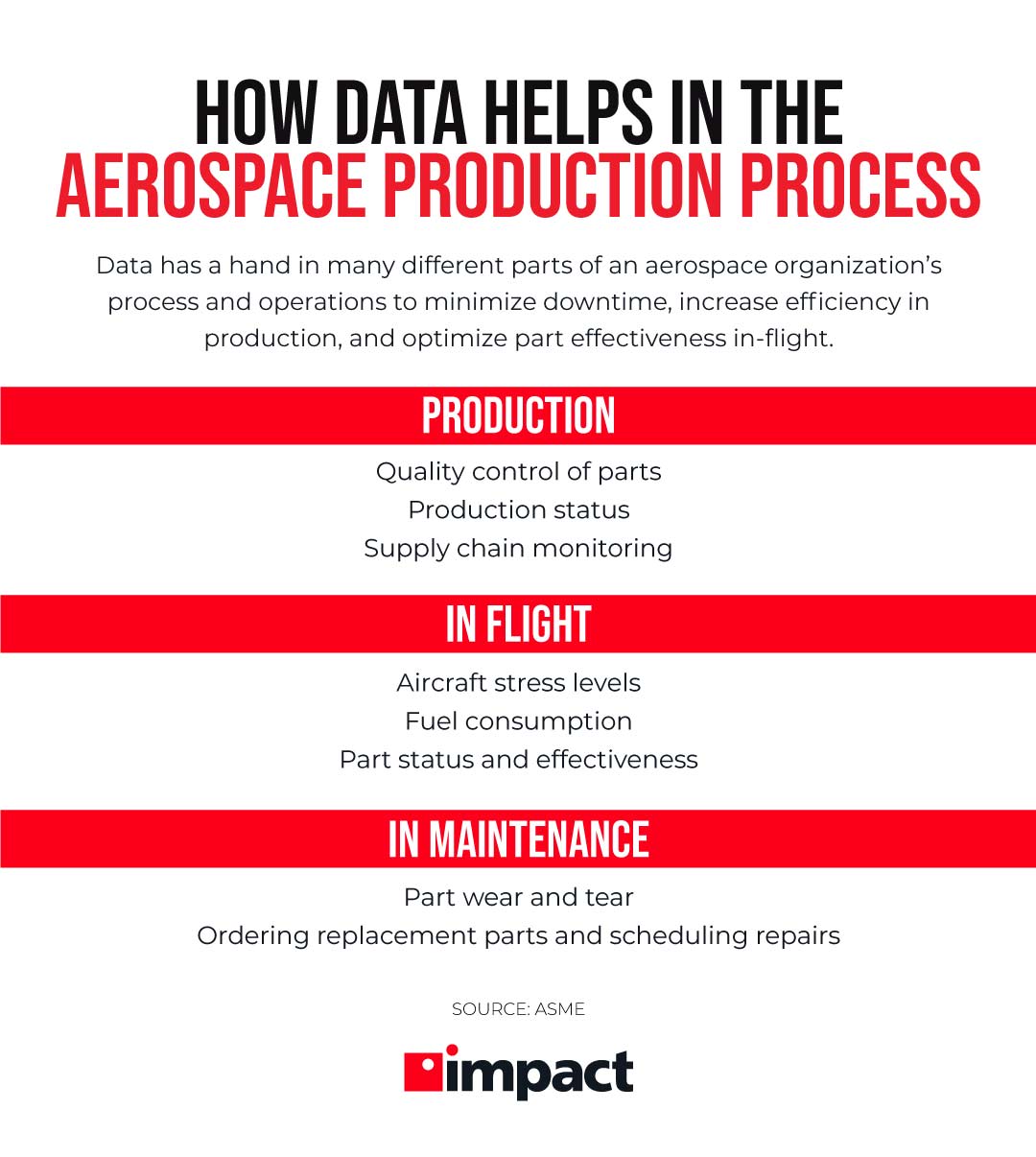Data has always been at the heart of the aerospace industry, and it’s used every day to track production progress, monitor product status, calculate flight plans, and make key decisions. But, the sheer amount of data being collected can make it a big challenge to identify which information is useful and how to best utilize it in everyday decision-making.
Read on to learn more about how aerospace organizations can improve the way they handle their data and how that data can be used to save money and improve efficiency across the board.
Modern organizations need to be equipped to utilize data that informs their processes and elevates their productivity. If you think you could use a hand, check out Impact’s eBook, Does Your Business Need a Managed IT Service Provider?
Data’s Role in Aerospace
Competition within the aerospace industry has gotten intense in the past decade with multiple companies vying for the same contracts and pushing toward similar goals. To get ahead, these organizations must find every competitive advantage that they can to eclipse their competitors, increase efficiency, and reduce mistakes.
The global fleet of commercial aircraft will generate over 2 billion terabytes of data per year while in flight
One major way this is being done is through the utilization of new and innovative data technology that improves operations across all stages of the product lifespan, from early conceptualizing to designing, production, after-market service, and even in-flight operations. Data collected from each stage of the process influences future designs by using the data to identify areas where efficiency, cost-efficacy, and part performance can be improved.
More effective storing, managing, and analyzing of data helps organizations make more informed, data-driven decisions that take steps toward reducing costs and maximizing revenue. Analyzing the effects of potential decisions, predicting outcomes, learning from past trends, optimizing processes, and more business decisions can be informed by real data.
Together, all this boils down to one takeaway: businesses within the aerospace industry collect a lot of data but face challenges when looking to organize, analyze, and make better use of it.
Understanding, analyzing, and utilizing data is a challenge that many organizations face on a daily basis. Having the right processes, people, and technology in place can facilitate strong data analysis and utilization.
Who Owns Data in the Aerospace Industry?
One question on many people’s minds in the aerospace industry is who owns the data being collected from parts, planes, software, etc.?
It’s no secret that aircraft are complex machines using parts, tools, and software from many different manufacturers and companies, all coming together. Similarly, aerospace data solutions are at their most effective when data is collected from multiple sources and comes together to give a full picture view of operations.
Aircraft operators claim that they should own the data collected during their operations, but manufacturers of specific parts also claim ownership. Some aerospace giants like Boeing operate under the idea that data should be accessible by whoever can create the most value from it rather than whoever owns it, leading to some general data-sharing agreements between companies.
This can lead to potential difficulties in extracting the most value and insights from collected data. Data sharing and data agreements might be important elements to note for the future to establish usability and ownership of data that can lead to valuable aerospace data solutions for organizations that collect, organize, and analyze their data.
Organizing Data in Aerospace
Organizing and managing collected data is about more than just bringing it all together into one collaborative space, it’s about sifting through it all, finding useful information, and getting that information into the right hands at the right time. With sensors in nearly every part of a plane, a single flight can produce thousands of terabytes of raw data that needs to be collected, stored, and analyzed in order to be of use in future decision-making.
That’s where aerospace data solutions like business intelligence, robotic process automation (RPA), and enterprise resource planning (ERP) come into play to help businesses streamline their data collection, more quickly analyze the data, and use AI and machine learning to provide key insights into trends and conclusions.
Benefits of Data Science in Aerospace
Data science is integral to many industries, and the more data an organization collects, the more important strong data science practices are. Using data science enables an organization to dive deeper into the data they collect with stronger analysis, higher validity, and better visibility.
Together, this creates an environment in which data can be effortlessly organized, refined, and managed.
Organizing and refining data comes with a lot of potential benefits for aerospace organizations. Mainly, it means being able to more easily access and utilize this data in all parts of the organization from shop floors to maintenance, to flight plans and more. Here are just a few examples of how data science influences aerospace operations.
Data-Driven Decision Making
As mentioned throughout this piece, the biggest benefit of having structured data is being able to easily access and use that data to influence decisions based on real-world trends and insights. Proper data management can quickly organize and make data available to every department in an organization to use at any point in their processes.
From initial concept and design to production and flight, effective data management can quickly organize and make data available to every department in an organization to use.
Predictive Analytics
Predictive analytics plays a big part in aerospace to help companies predict likely outcomes and appropriate responses using data. This reduces downtime and inefficiency by using data to predict repairs and maintenance and deciding when replacement parts need to be ordered in advance, making repairs quicker and overall fleet management more efficient.
Big data systems take everything into account when making these predictions, including smaller details like weather, to make insightful predictions.
Aerospace organizations can also utilize predictive analytics to forecast business and engineering decisions to assess the potential effects they’ll have.
For example, understanding how adding new routes, additional seats, and the adjustment of fares can all have major impacts on business and predictive analysis helps make informed decisions by analyzing trends and historical data to predict outcomes.
Flexibility in Data Storage and Collection
Data input systems need to be able to accept inputs from multiple sources, especially in aerospace where dozens of departments are collecting, storing, analyzing, and sharing data between them.
An effective data management system can accept inputs from all locations, and in different formats, to unify data storage and make it easier to collaborate using data from across the organization.
In Conclusion
With so much data being tracked and collected at all times, organizations within aerospace must seek out ways to streamline data collection and improve how they’re organizing and managing the data. This ensures that it’s readily available for use in decision-making to improve processes, track production, save money, and make overall more informed choices across the company.
If you want to learn more about how the right partner can help your business better use data innovatively, check out Impact’s eBook, Does Your Business Need a Managed IT Service Provider?


